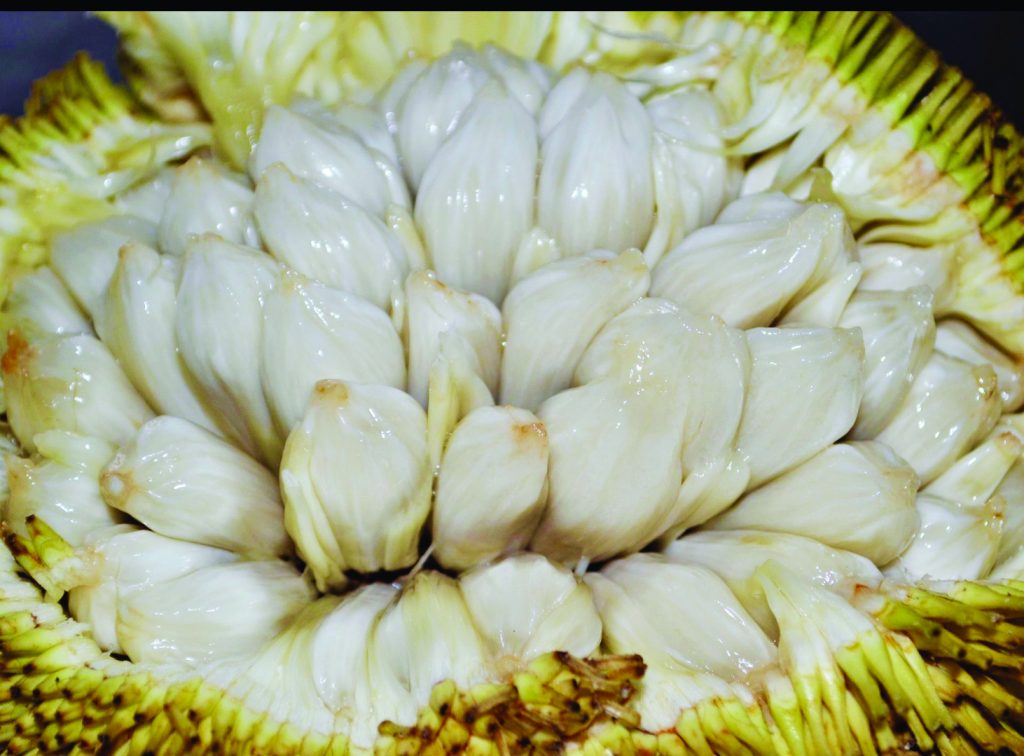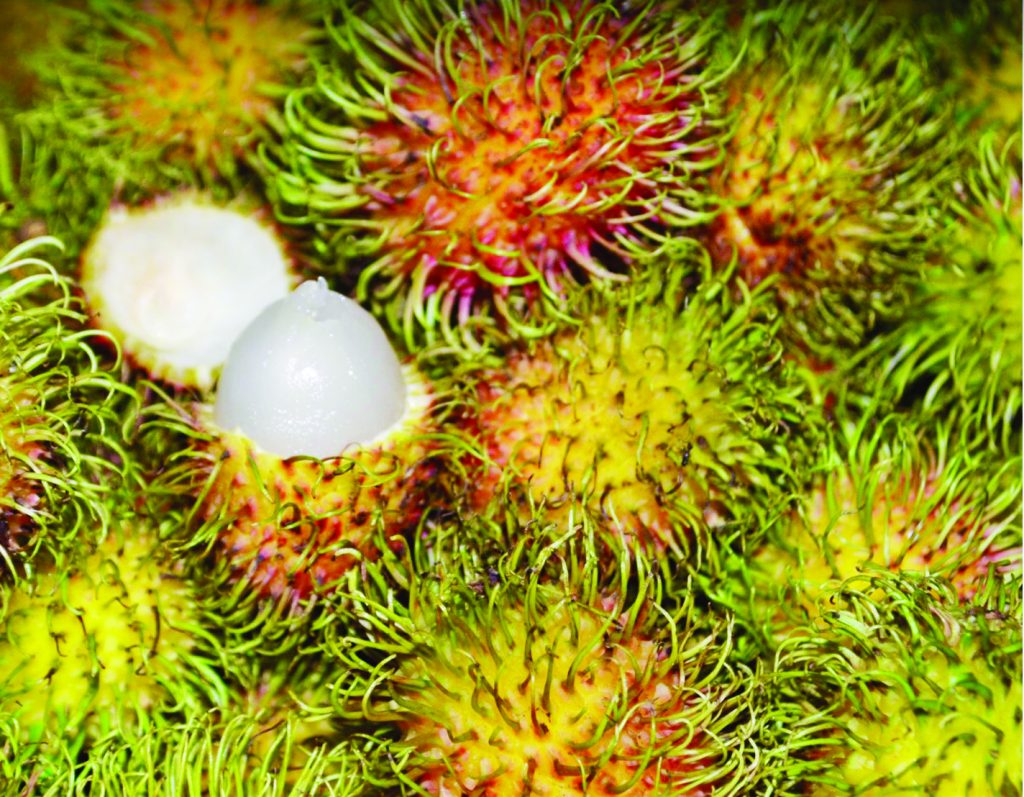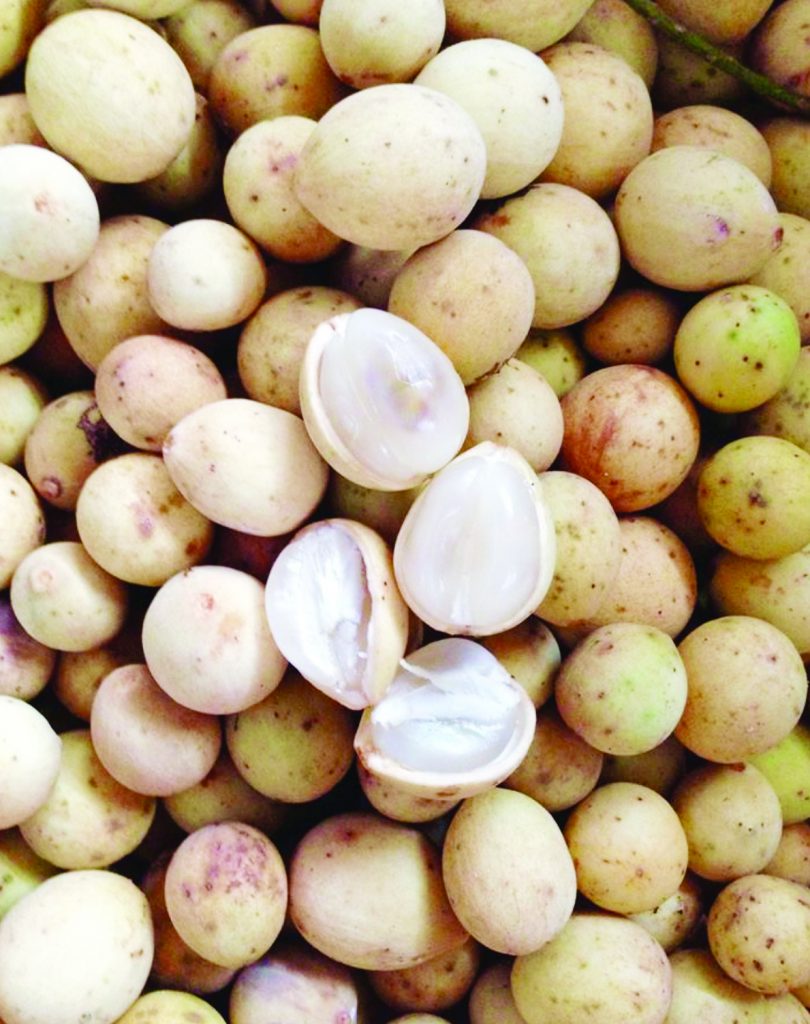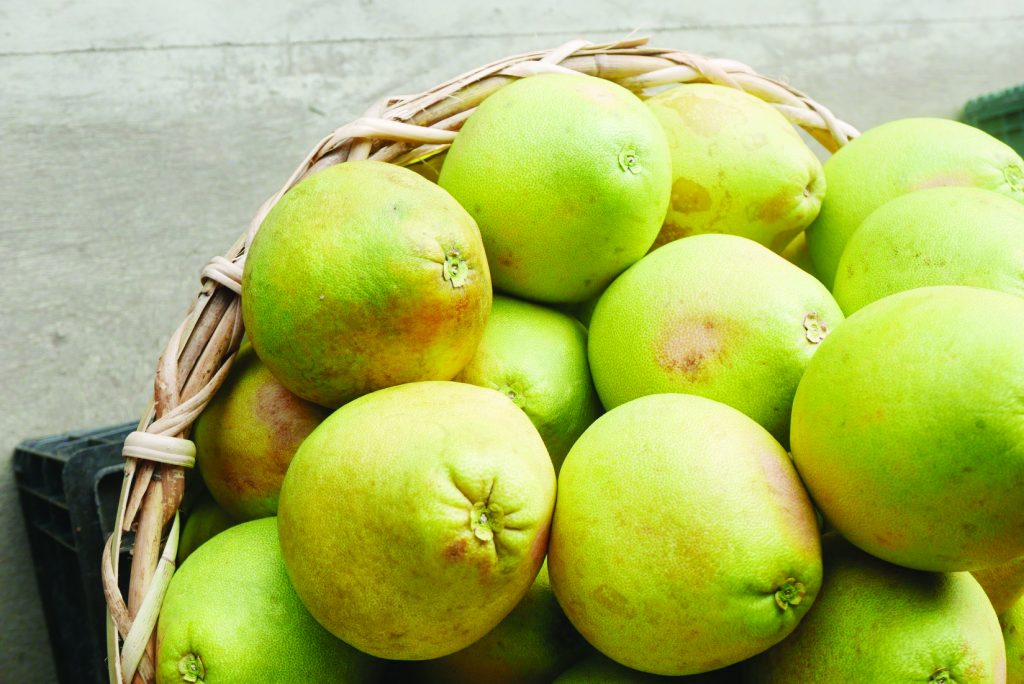Kadayawan sa Dabaw came into existence because of the bountiful harvest that happens once a year.
No wonder that during the Kadayawan month, fruits abound in Davao City. Don’t call it Kadayawan if these fruits are not around: durian, mangosteen, marang, lanzones, rambutan, banana and pomelo.
Durian

Topping the list is durian, which is native to the Philippines and its neighboring countries, particularly Brunei, Indonesia, and Malaysia. The fruit has been known to the Western world for about 600 years now.
Love it or hate it – there’s no emotion in between. The disagreement is due to its formidable look and overpowering odor. “Its odor is best described as pig-shit, turpentine and onions, garnished with a gym sock,” wrote travel and food writer Richard Sterling. “It can be smelled from yards away.”
While the “king of tropical fruits” is cherished by many who grew up around it, durian is often referred to as “that stinky fruit” by those who are not accustomed to the smell. In his book, Following the Equator, Mark Twain wrote about his durian experience through these words: “It was a most strange fruit, and incomparably delicious to the taste, but not to the smell.”
The late Angelo “Gil” M. Abarico, who served as press secretary of the late Governor Vicente G. Duterte, Davao City Mayor Elias B. Lopez and later Mayor Rodrigo R. Duterte had a classic description of durian. He said it is the fruit which smells like hell but tastes like heaven.
Mayor Lopez, Abarico’s boss would describe durian, half-joking as the “fruit of understanding.” Once you have eaten it, your under will stand. Strengthening the claim that the fruit is an aphrodisiac, like a love drug that can raise eater’s libido.
For those who want to taste durian for the first time, be sure to buy the very best. But how will you know that the durian you are buying is the real thing? Here’s a tip from the experts: “When picking a durian to buy, look at the stem, if it is dry the durian is probably old. If the stem is cut off, shake the fruit and listen for the seeds knocking around; if you hear something the pulp has probably lost some moisture and therefore not as tasty.”
Mangosteen

If durian is the king, mangosteen is the “queen of tropical fruits.” British-born Malaysian author Desmond Tate wrote in his book, Tropical Fruits: “By popular acclaim, the mangosteen is held to be the most delectable of all tropical fruits, and has been proclaimed their queen. There is no doubt about the luxury of its taste. It has won unstinted praise down the ages from all who have encountered it.”
A Westerner, who once traveled to Asia, wrote after eating the fruit: “The pulp melts away in your mouth after the manner of a ripe peach or strawberry; it has a taste which nobody can describe any more than he can tell how a canary sings or a violet smells…”
In an article which appeared in The New York Times, R.W. Apple. Jr. hailed: “No other fruit, for me, is so thrillingly, intoxicatingly luscious, so evocative of the exotic East, with so precise a balance of acid and sugar, as a ripe mangosteen. I thought so when I first tasted one half a lifetime ago, and I’ve thought so ever since.”
Mangosteen is usually eaten fresh as dessert. Hold the fruit with the stem-end downward, take a sharp knife and cut around the middle completely through the rind, and lift off the top half, which leaves the fleshy segments exposed in the colorful “cup” – the bottom half of the rind. Lift out the segments by fork.
Marang

Some people think marang is the same as that of durian – minus the “smell like hell” distinction. Actually, it is more comparable to “kamansi” (breadfruit) and “langka” (jackfruit). Unlike durian, marang is less controversial. One scribe wrote of its smell as something “like gasoline” but whose taste is a combination of “pears, jackfruit and pineapple.”
Here’s what the scribe actually wrote: “Marang has an odor that will funk up a rom the same way that durian does. The scent is something like gasoline, but don’t let that deter you; the sticky white flesh inside tastes like a fruit crop.”
Wikipedia has another description of its taste: “The taste has hints of a mild creamy, almost juicy banana, and is best when not allowed to ripen thoroughly on the tree.” Most of those who like marang will definitely agree on this.
Rambutan

In episode 5 of Netflix science fiction series “Another Life,” a pair of characters came across an “alien-looking” fruit. The prop used was actually the rambutan, whose name is derived from the Malay word rambut which means “hair.”
The fruit is native to Indonesia and was introduced into the country in 1912.
Unlike durian and marang, rambutan has no controversial odor. Its pleasant fragrance comes from numerous volatile organic compounds, including beta-damascenone, vanillin, phenylacetic acid, and cinnamic acid.
There are two types of rambutan being grown in the country and they can be distinguished by their seed. The common rambutan seed and fruit are difficult to separate while the “Maharlika” rambutan fruit separates cleanly from its seed. The second is more popular among consumers.
Lanzones

Although a promising fruit, lanzones is one of the most neglected fruit crops. “Lanzones is a very wholesome fruit popular even in areas where it is grown as backyard tree or grown under coconut and other tall trees,” states a technology guide published by the University of Southern Mindanao. “The fruit has a sweet to sub-acid taste and milky juice which contains high nutritional value.”
The sweet juicy flesh contains sucrose, saccharose, fructose and glucose. The seed and rind is rich in tannin and contain chemical substances that are medicinally and industrially useful. The fresh peeling yielded a volatile oil, a resin, and some reducing acids. The resin is believed to be nontoxic and protective to the stomach against alcohol.
The decoction of bark and leaves is used for dysentery. The powdered bark is used to treat scorpion stings. The bark resin can be used for swellings, and is considered as an anti-spasmodic. Tincture prepared from the dried rind used for diarrhea. The dried fruit skins when burned emit an aromatic smell which repels mosquitoes. It also makes a pleasant room inhalant.
Pomelo

Known in the science world as Citrus maxima, pomelo is actually one of the top “pasalubong” items from Davao to Cebu, Manila and other parts of the country. Evident of this is the continued existence of at least two dozen fruit stands along Ponciano Street and other parts of the city especially near the Davao City International Airport and the city’s public markets.
The pomelo is native to Southeast Asia. In Thailand, the fruit is called som-o, and is eaten raw, usually dipped into a salt, sugar and chili pepper mixture. In some parts of the region, it is a popular after lunch snack once it is sprinkled with salt and sliced hot pepper. In rural areas, children often use it as a football.
Pomelo is one fruit which has a lot of uses from the outside to the inside. While the fruit pulp is the main reason why people buy pomelo, the peel is also very useful and can be turned into marmalade. The peel can also be sued as flavoring.
Pomelo has actually found more uses in the Dabawenyocuisine than what was traditionally practiced. Aside from being consumed raw, the fruits are now used in the preparation of juices and salads.
Banana

In popular culture and commerce, “banana” usually refers to soft, sweet “dessert” bananas that are usually eaten raw. The bananas from a group of cultivars with firmer, starchier fruit are called plantains, and are generally used in cooking rather than eaten raw. The word “banana” is derived from the Arabic word “finger.”
In The Healthy Food Directory, author Michael Van Straten ranks banana near the top because the fruit helps alleviate 14 medical conditions. “The banana is nature’s wonder fruit and the perfect fast food,” hailed Dr. Willie T. Ong in his book, How to Live Longer.
There are several kinds of bananas grown in Davao but the most popular ones are the latundan,lakatan, and saba. These are mostly grown in the backyard or as a component in an intercropping scheme with minimum care and management.
Cavendish is the export variety grown by commercial banana plantations in nearly 100,000 hectares in Davao and other regions in Mindanao .






